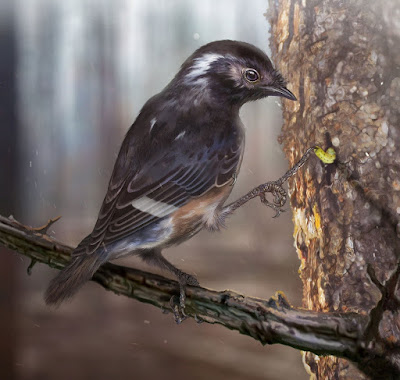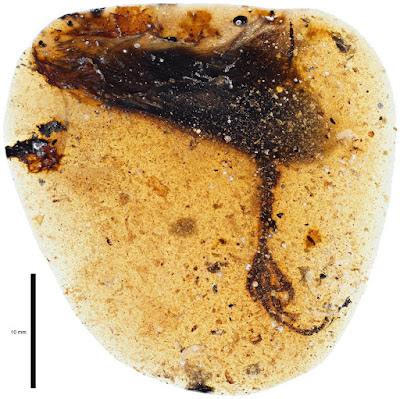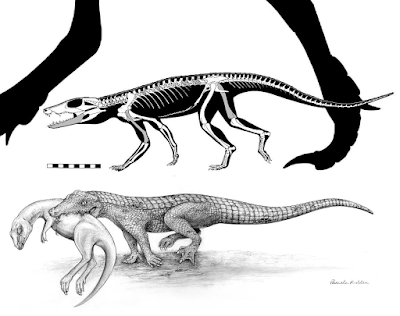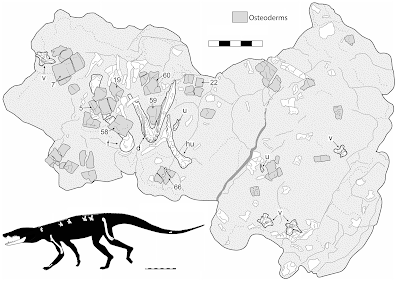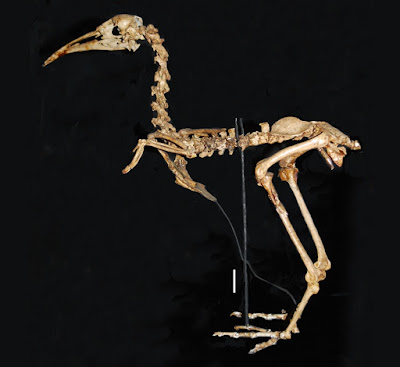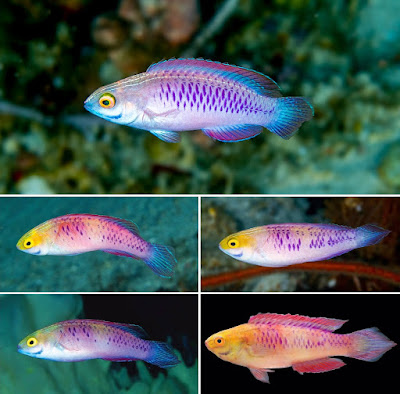[Most Recent Entries] [Calendar View]
Friday, July 12th, 2019
| Time | Event | ||||
| 4:48a | [PaleoOrnithology • 2019] Elektorornis chenguangi • A New Enantiornithine Bird with Unusual Pedal Proportions Found in Amber
Highlights: • New fossil is first avian species recognized from amber • Elektorornis is distinct from all other birds based on the proportions of the foot • Scutellae scale filaments on foot suggest probing function for elongated third toe Summary Recent discoveries of vertebrate remains trapped in middle Cretaceous amber from northern Myanmar have provided insights into the morphology of soft-tissue structures in extinct animals, in particular, into the evolution and paleobiology of early birds. So far, five bird specimens have been described from Burmese amber: two isolated wings, an isolated foot with wing fragment, and two partial skeletons. Most of these specimens contain the remains of juvenile enantiornithine birds. Here, we describe a new specimen of enantiornithine bird in amber, collected at the Angbamo locality in the Hukawng Valley. The new specimen includes a partial right hindlimb and remiges from an adult or subadult bird. Its foot, of which the third digit is much longer than the second and fourth digits, is distinct from those of all other currently recognized Mesozoic and extant birds. Based on the autapomorphic foot morphology, we erect a new taxon, Elektorornis chenguangi gen. et sp. nov. We suggest that the elongated third digit was employed in a unique foraging strategy, highlighting the bizarre morphospace in which early birds operated. Keywords: Cretaceous, Cenomanian, Burma, Hukawng, stem Aves, Enantiornithes, ecology, feathers
Systematic Paleontology: Aves Linnaeus 1758 Ornithothoraces Chiappe 1995 Enantiornithes Walker 1981 Elektorornis gen. nov. Elektorornis chenguangi gen. et sp. nov. Etymology: Elektorornis, ‘‘Elektor,’’ the word for amber; ‘‘-ornis,’’ Greek, meaning bird. The species name ‘‘chenguangi’’ is in honor of Chen Guang, a curator at the Hupoge Amber Museum. Lida Xing, Jingmai K. O’Connor, Luis M. Chiappe, Ryan C. McKellar, Nathan Carroll, Han Hu, Ming Bai and Fuming Lei. 2019. A New Enantiornithine Bird with Unusual Pedal Proportions Found in Amber. Current Biology. In Press. DOI: 10.1016/j.cub.2019.05.077 Bird with unusually long toes found fossilized in amber phys.org/news/2019-07-bird-unusually-toe | ||||
| 9:22a | [Paleontology • 2019] Tarsomordeo winkleri • Small Terrestrial Crocodyliform from the Lower Cretaceous (late Aptian) of central Texas and Its Implications on the Paleoecology of the Proctor Lake Dinosaur Locality
ABSTRACT Within the Twin Mountains Formation, the Proctor Lake dinosaur locality in central Texas is distinct from other Early Cretaceous localities by having an abundance of vertebrate fossils representing a low-diversity assemblage. However, it has yielded two small-bodied crocodyliforms, Wannchampsus kirpachi and Tarsomordeo winkleri, gen. et sp. nov. This new species is represented by a single partial skeleton with a complete dentary, trough-shaped mandibular symphysis, amphicoelous vertebrae, nearly square dorsal osteoderms, and gracile, elongated limbs. In addition, limb morphology indicates a parasagittal posture, an attribute for a terrestrial lifestyle that could have allowed T. winkleri to fill an ecological niche as an active predator of nesting dinosaurs and other small prey. A phylogenetic analysis places this new taxon within Eusuchia as a member of Paralligatoridae and the sister taxon to Paralligator major and Rugosuchus nonganensis, providing further evidence for the presence of this clade in North America. This new Proctor Lake crocodyliform expands the taxonomic diversity of the Early Cretaceous units of central Texas and provides additional insight into the paleoecology of the Proctor Lake dinosaur nesting site.
SYSTEMATIC PALEONTOLOGY CROCODYLIFORMES Hay, 1930 MESOEUCROCODYLIA Whetstone and Whybrow, 1983 NEOSUCHIA Benton and Clark, 1988 PARALLIGATORIDAE Konzhukova, 1954 TARSOMORDEO, gen. nov. Type Species— Tarsomordeo winkleri, sp. nov. Etymology—‘Tarso’ and ‘mordeo,’ derived from the Latin terms for ‘ankle biter’ in reference to the small size of the type specimen. TARSOMORDEO WINKLERI, sp. nov. Etymology— Tarsomordeo winkleri, in honor of Dr. Dale Winkler, for his contributions to the study of Texas paleontology and geology. Thomas L. Adams. 2019. Small Terrestrial Crocodyliform from the Lower Cretaceous (late Aptian) of central Texas and Its Implications on the Paleoecology of the Proctor Lake Dinosaur Locality. Journal of Vertebrate Paleontology. e1623226. DOI: 10.1080/02724634.2019.1623226 Witte paleontologist discovers ancient cat-sized crocodile species that hunted on land kens5.com/article/life/animals/witte-pal Kate A. Andrzejewski, Dale A. Winkler and Louis L. Jacobs. 2019. A New Basal Ornithopod (Dinosauria: Ornithischia) from the Early Cretaceous of Texas. PLoS ONE 14(3): e0207935. DOI: 10.1371/journal.pone.0207935 | ||||
| 9:41a | [Ornithology • 2019] Systematics, Morphology and Ecology of Rails (Aves: Rallidae) of the Mascarene Islands, with One New Species
Abstract Five species in five genera of extinct endemic rails have been described from the Mascarene Islands of Mauritius, Réunion and Rodrigues: the Mauritian Red Rail or Poule Rouge Aphanapteryx bonasia; Mascarene Coot or Poule d’eau Fulica newtonii; which occurred on Mauritius and Réunion; Réunion Wood Rail Dryolimnas augusti; Réunion Gallinule or Oiseaux bleu ‘Porphyrio caerulescens’; and Rodrigues or Leguat’s Rail Erythromachus leguati. All are known from fossil remains and/or from contemporary accounts and illustrations. A sixth species of rail Dryolimnas sp. nov. is described herein from fossils from Mauritius, but was not unequivocally previously reported in the contemporary literature. This paper provides an analysis of the Rallidae of the Mascarene Islands based on existing and newly discovered fossil remains, and details historical reports and accounts. Comprehensive osteological descriptions and synonymies are also included. Their ecology and extinction chronologies are interpreted from historical evidence. The relationships of Aphanapteryx and Erythromachus are unresolved, having clearly been isolated for a considerable time; the middle Miocene is the earliest their ancestors could have arrived on the Mascarenes, but this may have happened more recently. Mascarene derivatives of Fulica, Porphyrio and Dryolimnas are of much more recent origin, and appear to have originated in Africa or Madagascar. All terrestrial rails on Mauritius, Réunion and Rodrigues, were probable victims of cat predation following their historic introduction to the islands, whereas over-hunting by humans was probably the primary cause of extinction of ‘Porphyrio caerulescens’ on Réunion. The only extant rail on the Mascarenes today, the Madagascar race of Eurasian Moorhen Gallinula chloropus pyrrhorrhoa, is a recent arrival, having colonised Mauritius and Réunion after the extinction of Fulica newtonii. Keywords: Aves, Mascarene rails, Rallidae, Aphanapteryx, Erythromachus, Dryolimnas, Porphyrio, Gallinula, Leguatia, extinction, affinities, ecology, sexual dimorphism
Julian Pender Hume. 2019. Systematics, Morphology and Ecology of Rails (Aves: Rallidae) of the Mascarene Islands, with One New Species. Zootaxa. 4626(1); 1–107. DOI: 10.11646/zootaxa.4626.1.1 | ||||
| 10:02a | [Ichthyology • 2019] Cirrhilabrus wakanda • A New Species of Fairy Wrasse (Teleostei, Labridae) from Mesophotic Ecosystems of Zanzibar, Tanzania, Africa
Abstract Cirrhilabrus wakanda sp. nov. is described on the basis of the holotype and four paratypes collected between 50 and 80m depth over low-complexity reef and rubble bottoms at the east coast of Zanzibar, Tanzania, Africa. The new species belongs to a group of fairy wrasses from the western Indian Ocean, sharing a combination of characters that include: short pelvic fins (not or barely reaching anal-fin origin); relatively unmarked dorsal and anal fins; males with a strongly lanceolate caudal fin (except in C. rubrisquamis); both sexes with a pair of prominent facial stripes above and below the orbit; and both sexes with prominent purple scales and osseus elements that persist, and stain purple, respectively, even in preservation. This group of fairy wrasse is part of a larger complex that includes related species from the western Pacific Ocean. In addition to meristic and morphometric comparisons, we also compare mitochondrial DNA sequence data to the aforementioned, putatively related species. Keywords: Coral reefs, deep reefs, Indian Ocean, rebreather diving, reef fish Cirrhilabrus wakanda sp. nov. Vibranium fairy wrasse Diagnosis: Cirrhilabrus wakanda shares similar meristic characters to other members of this genus. However, it is readily distinguished from all other Cirrhilabrus in having the following combination of colouration and morphological characters: caudal fin strongly lanceolate in males; both sexes with a series of purple scales (in life and in preservation) arranged in a chain-link pattern across dorsal two-thirds of body. Etymology: The specific epithet refers to the fictional East African nation of Wakanda, home of the superhero Black Panther, as is the case for the new species, which has remained hidden from the world for a long time. To be treated as a noun in apposition. The common name refers to the fictional metal vibranium, a rare substance found on Wakanda that is woven into Black Panther’s suit. The purple chain-link scale pattern of the new species is reminiscent of this detail. Distribution and habitat: Cirrhilabrus wakanda is presently known only from the east coast of Zanzibar, Tanzania. The species inhabits deep shelves consisting of small patch reefs dominated by rhodolith and sponge beds, at depths between 50 and 80 m. Yi-Kai Tea, Hudson T. Pinheiro, Bart Shepherd and Luiz A. Rocha. 2019. Cirrhilabrus wakanda, A New Species of Fairy Wrasse from Mesophotic Ecosystems of Zanzibar, Tanzania, Africa (Teleostei, Labridae). ZooKeys. 863: 85-96. DOI: 10.3897/zookeys.863.35580 twitter.com/CoralReefFish/status/1149303530890678272 Wakanda Forever! Scientific divers describe new purple species of “twilight zone” fish from Africa https://blog.pensoft.net/2019/07/11/waka |
| << Previous Day |
2019/07/12 [Calendar] |
Next Day >> |
